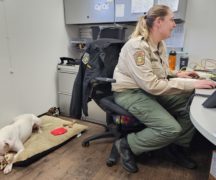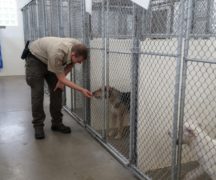By JAN LARSON McLAUGHLIN
BG Independent News
The Wood County dog warden is not like an old dog that can’t be taught new tricks.
Chief Dog Warden Andrew Snyder said Tuesday morning that he is always looking for ways to improve operations at the county dog shelter. Those changes include more visible signage for the shelter, more dog license sales, increased outdoor exercise for the dogs, improvements to the dog park, decreases in dogs euthanized, and increased efforts to find homes for impounded dogs.
Last Friday, approximately 50 protesters rallied in downtown Bowling Green to protest dogs being euthanized at the Wood County Dog Shelter.
Snyder reported to the county commissioners Tuesday that the dog shelter’s euthanasia rate is 8 percent – far lower than the 40 percent rate a decade ago.
Of the 184 dogs impounded so far this year, 81 were reclaimed by their owners, 45 were adopted by new owners, 35 were taken in by rescue organizations, and 15 were euthanized.
“I think our adoption statistics show we have a really good relationship with our rescues,” he said.
Commissioner Doris Herringshaw asked if some dog owners surrender their dangerous dogs to the shelter for euthanasia. “Do they bring them to you with that in mind?”
Snyder said that does occur, and added that some owners drop off older ill dogs.
On Monday, the shelter took in four new dogs, he said. One was a pit bull whose owner has been incarcerated, and the family cannot take in the dog because it is aggressive toward other dogs.
“We take in a dog like that and do our best to find that dog a home,” Snyder said. But fewer rescue groups are available to take in such dogs. “It’s a never ending process to try to find a home for these dogs.”

New sign designed for in front of dog shelter
Snyder reported on some improvements to the commissioners, such as:
- Revisions to a kennel worker’s hours now allow the dogs to get outdoor exercise time six days a week.
- A new, more visible sign will be erected at the dog shelter, located in the county complex off East Gypsy Lane Road. Other signage options are being considered at an entrance to the complex.
- Workers have made more door-to-door checks for dog licenses, which should result in more license sales this year.
- More “dangerous” dog licenses have been purchased, as required by state law. “So we’re seeing more compliance there,” Snyder said.
Changes are also planned at the county dog park, located next to the dog shelter. The three padlocked entrances to the dog park will be replaced with one keypad entrance. That should make it more convenient for members, and more likely they will lock it when leaving.
Drainage issues will be fixed, and a water cooler system will be installed, Snyder said. Running water to the park was too expensive, he added.

County commissioners meet with dog warden.
After the meeting with the commissioners, Snyder talked about some of the reasons possibly causing the lower number of dogs being impounded at the shelter. In 2005, there were more than 800 dogs taken in. Last year, that number was just over 400.
More dogs are now being licensed, so they are immediately returned to their owners instead of having to go to the dog shelter, he said. Also, there has been an increase in public awareness about pet owner responsibilities and the importance of adopting from shelters, thanks to several TV shows that touch on the topic. And social media is used by several people to find lost pets.
Snyder said he is willing to consider policy changes at the dog shelter, including tweaking the process of evaluating dog behaviors. However, he said he must continue to keep the county’s liability and the public’s safety in mind.
“We aren’t a humane society,” and cannot devote the time needed to rehabilitate dog behavior, he said. “We’ve got these legal obligations.”
If a dog is dropped off at the shelter by an owner reporting it has bitten someone, the shelter has to take that into consideration even if there is no official bite report, Snyder said.
“If we place a dog that we know has bitten someone, and it bites someone, it’s the county’s responsibility,” he said. “We wouldn’t want to jeopardize the safety of the public.”
Snyder also mentioned that he would welcome more volunteers at the shelter. Though privileges were revoked in the past from one volunteer, they have been reinstated.
“We have never turned anybody away,” he said. “We want volunteers.”




